Speech Australian Financial Markets: Looking Back and Looking Ahead

Ric Battellino
Assistant Governor (Financial Markets)
Address to the Australian Finance and Capital Markets Conference
Sydney –
In my talk today, I would like to cover three issues:
- How have Australian financial markets changed in the 15 or so years since financial deregulation was completed?
- How do they compare with those in other countries?
- How might they develop over the next 15 years?
Changes since Financial Deregulation
It has now been about 15 years since the process of financial deregulation in Australia was completed. The process had started in the 1970s with the gradual removal of controls over bank interest rates, but picked up speed in the early 1980s. Key steps along the way were the removal of other controls on banks, freeing up of interest rates on government securities (by adopting tender arrangements for new issues), floating the exchange rate and finally, in the mid 1980s, opening up the banking system to foreign competition.
What has been the impact of this on financial markets and the financial system more generally? It is not possible to answer this question with precision, of course, because the impact of deregulation cannot be disentangled from the other forces at work, such as technological change and economic development. But, notwithstanding this qualification, I would say that deregulation has contributed to four key financial developments over the past 15 years:
- strong growth in the size of financial markets and in their sophistication;
- an increase in the overall size of the financial sector relative to the economy;
- a tendency towards disintermediation – i.e. for borrowers and lenders to bypass financial intermediaries and deal directly with each other; and
- increased efficiency in the financial system, with competitive pressure (eventually) reducing interest margins and putting downward pressure on costs.
The expansion of financial markets
There can be no doubt that over the past 15 years there has been tremendous development in Australia's financial markets. Growth in turnover in the major market sectors has generally exceeded 20 per cent a year over the period, or about three times the rate of growth of nominal GDP (Table 1). The main exception to this is the Commonwealth Government securities market, where turnover has levelled off recently as the amount of this debt on issue has fallen with a run of budget surpluses.
| 1985$m | 1999$m | Average annual growth Per cent | |
|---|---|---|---|
| Foreign exchange | 5,000 | 77,000 | 22 |
| Bond market | |||
| Securities | 1,000(a) | 4,000 | 14 |
| Futures contracts | 100 | 7,000 | 35 |
| Money market | |||
| Securities | 600(a) | 7,000 | 20 |
| Futures contracts | 1,000 | 30,000 | 26 |
| Repurchase agreements | 200(a) |
15,000 |
38 |
| Equities | |||
| Physical | 50 | 1,000 | 26 |
| Futures contracts | 100 | 2,000 | 21 |
| Memo item: | |||
| Nominal GDP(b) | 230,000 | 600,000 | 7 |
|
(a) Estimated Sources: Australian Financial Markets Report, AFMA, 1999; Sydney Futures Exchange; Australian Stock Exchange. Figures for foreign exchange, physical securities and repurchase agreements are on a financial year basis; futures contracts are on a calendar year basis. |
|||
A feature of Australian markets is that they have developed in a balanced way, with foreign exchange, fixed interest, money and equity markets all increasing at broadly similar rates over the period. Some people may find this unremarkable, but it does not always happen. In some countries, for example, lopsided markets develop – e.g. with foreign exchange trading being disproportionately large.
The balanced development in Australia reflects both a lack of regulatory distortions (or incentives) and the fact that Australian markets have developed primarily to service the domestic economy, which is itself quite large and diversified.
The one segment of the market that was slow to develop was the domestic corporate bond market. Only very recently has it grown to any size. Previously, strong competition from the euro markets and the banking sector, and high inflation, tended to retard the growth in this market.
The rise in market activity has been accompanied and underpinned by improvements in market infrastructure. In the prudential sphere, Australia adopted the Basel capital framework for banks early in the piece. Australia's settlements systems – Austraclear, RITS and CHESS – comply with the highest international standards and Australia's RTGS system is among the best with a very high coverage of wholesale transactions and integration of securities and funds flows.
The rise in financial activity more generally
The expansion in financial activity has not been confined purely to market trading. Holdings of financial assets by the community have expanded rapidly – at a much faster rate than national income (Graph 1).
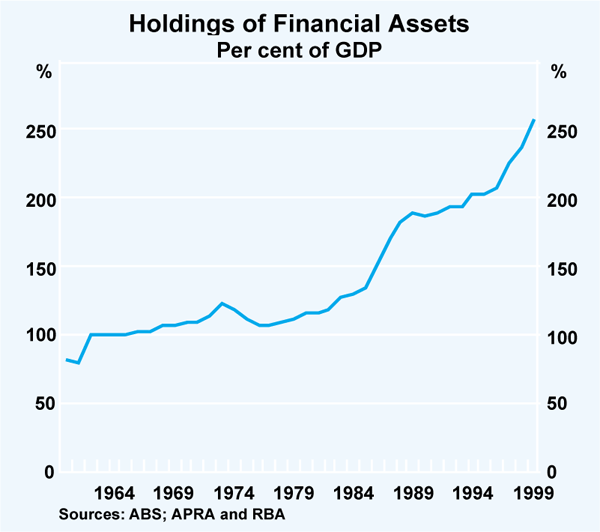
In the 1960s and 1970s, the ratio of financial assets to GDP was fairly steady, at a little over 100 per cent – i.e. holdings of financial assets were about the same size as national income. This was a period when access to financing was rationed through quantitative controls, and it is clear now that this stopped the development of the financial system. The ratio of financial assets to GDP has since increased to over 250 per cent, with the community's holdings of financial assets having increased on average by 12 per cent a year since the mid 1980s, almost twice the pace of nominal GDP growth.
As I will show in more detail later, this tendency for financial assets to grow faster than income is common in most developed countries, but particularly in those that have deregulated markets. It reflects not only the accumulation of wealth but increased specialisation in the financial system.
Disintermediation
Not all sectors of the financial system have shared equally in this expansion. Non-bank financial intermediaries – credit unions and building societies – have in fact shrunk in size as the competitive advantage they had enjoyed when banks were regulated has been removed (Graph 2).
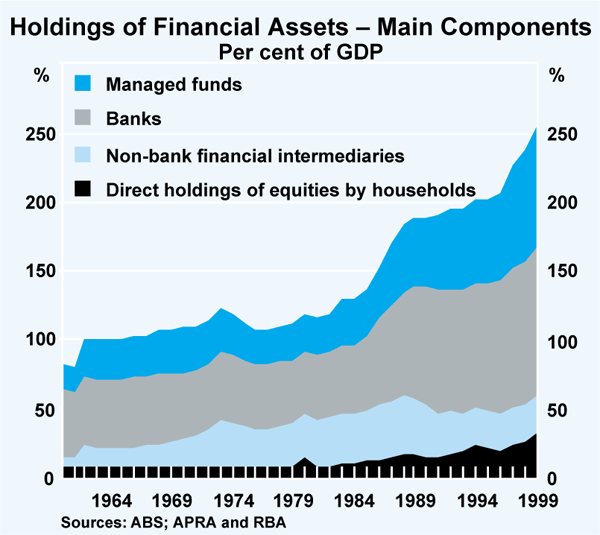
Banks responded quickly to deregulation, with a very sharp expansion in financing in the mid-to-late 1980s (with subsequent temporary adverse consequences for their profitability). The community's holdings of financial assets with banks are still growing faster than income, but they are no longer the fastest growing segment. Rather, that honour now goes to funds managers. In addition, recently there has been a substantial increase in direct holdings of financial assets (mainly equities). A recent survey by the Australian Stock Exchange showed that 54 per cent of adult Australians now hold shares directly or through personally managed funds, up from 22 per cent in 1991.
This relative shift in assets away from intermediaries towards funds managers and direct holdings is being pushed from both the demand and supply sides. An important influence has been the expansion of superannuation. Practically all permanent employees now receive superannuation benefits, compared with 45 per cent 15 years ago (Graph 3). This is diverting savings into funds managers rather than traditional intermediaries, which is in turn creating demand for securities and allowing borrowers to approach the market directly rather than seeking loans from intermediaries. The process has been supported by improved market infrastructure – e.g. information systems, custody and settlement facilities, and ratings agencies – which has made it easier for borrowers and lenders to deal directly with each other.
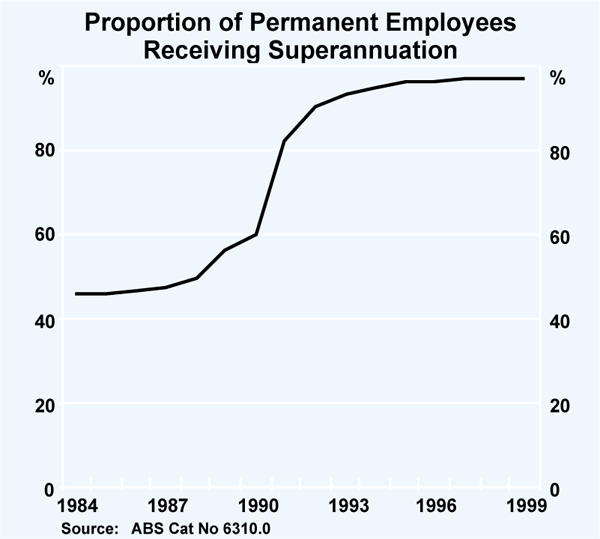
In the background, another factor has been at work. More explicit recognition by banks of their cost of capital has seen them become more willing to shift assets off their balance sheets if they consider that those assets are not providing a sufficient return.
With banks' traditional borrowing and lending activities under strong competitive pressure, they have had to diversify the range of services they provide, transforming themselves from relatively narrowly-based intermediaries to diversified financial service providers. Part of this has been through their banking arms (the expansion into new lending products such as home-equity loans and margin lending), part has been by supplying assets to the funds managers through securitisation, and part has been by moving directly into funds management, insurance and so on.
One market segment that has benefited from all this, particularly in an environment where governments have sharply cut back on their issues of securities, is the non-government bond market. This market was slow to develop in the early post-deregulation period but it has increased very quickly in recent years.
The stock of non-government bonds on issue has increased threefold over the past four years to $66 billion, surpassing State Government paper on issue ($52 billion) and within reach of Commonwealth Government securities on issue (Graph 4). It is worth noting, of course, that liquidity in this market still falls a long way short of that in Commonwealth or State Government paper (Graph 5).
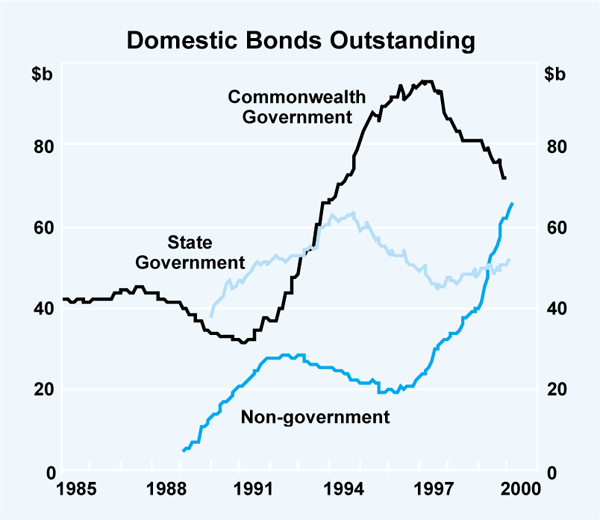
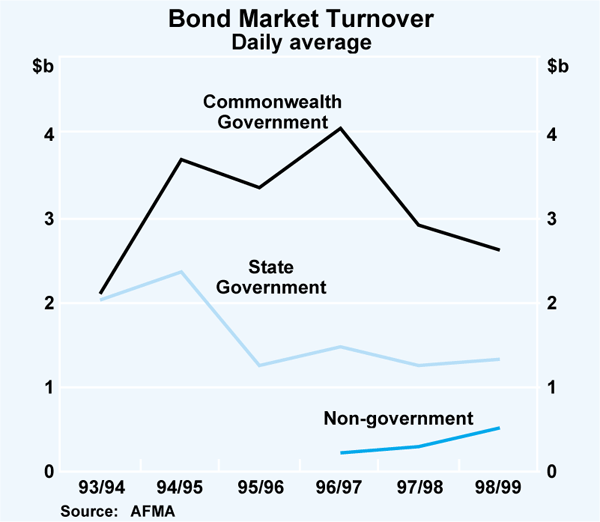
There is substantial scope for the market in non-government bonds to grow further, as it is still relatively small by international standards. For example, only about 10 per cent of housing loans are securitised in Australia, compared with 50 per cent in the United States.
Falling margins and cost reductions
One of the consequences of deregulation was expected to be increased competition. Signs of this are now clearly evident in the financial system, but the process took longer than expected to work through.
One of the factors that contributed to the slowness of the response was high inflation and the high interest rates that accompanied it. In that environment, banks had such a strong competitive advantage through their ability to raise low-cost retail deposits that other lenders, which had to rely on higher-cost wholesale funds, could not compete. It was not until the fall in inflation and interest rates in the 1990s that alternative lenders began to get a foothold, and the process of reducing interest margins began to accelerate.
Interest margins of banks are now about 40 per cent lower than in the late 1980s. Housing borrowers and, more recently, small businesses, have been the main beneficiaries. This fall in margins has been reflected in the operating income of banks decreasing from about 5.5 per cent of assets to about 4 per cent now, notwithstanding increased income from fees (Graph 6). To some extent, increased fees have been one of the by-products of increased competition in lending, as the latter has reduced the ability of banks to cross-subsidise services – i.e. pressure on interest margins has reduced banks' capacity to use this source of income to subsidise other services to retail clients.

The fall in banks' operating income has been matched by a similar fall in operating costs. In other words, increased competition has led to cost reductions rather than falling profits. Banks' return on equity remains about the same now as in the second half of the 1980s (Graph 7). One sign of the downward pressure being applied to costs can be seen in the employment figures for the finance sector. Even though total financing activity in the economy has expanded over the past 15 years at a rate about twice that of GDP, employment in the finance sector has fallen relative to total employment (Graph 8). The sector now accounts for 3½ per cent of total employment, compared with 4½ per cent in the second half of the 1980s. No doubt, within this, there has been a big compositional swing away from bank tellers to funds managers and investment bankers.

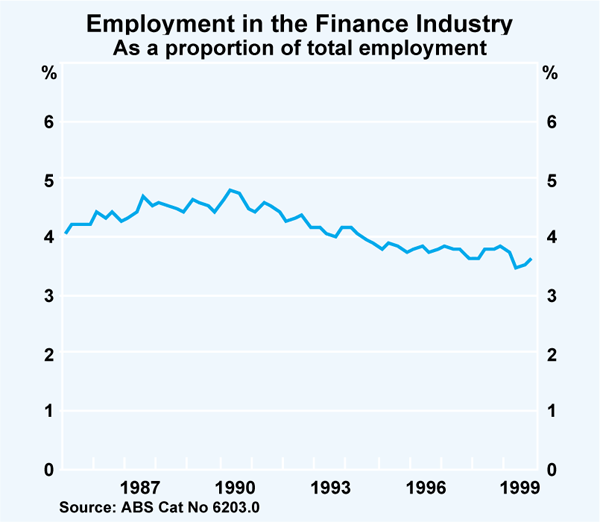
What about funds managers' fees? This industry in Australia is at an earlier stage of development than banking, so we should not yet expect to see the same degree of pressure on margins. But some signs of reduced fees have been evident recently. According to Intech, the average fee charged on specialist domestic share funds has fallen by 11 per cent over the past three years, while that on specialised fixed-interest funds has fallen by 7 per cent. Fees on pooled superannuation funds, on the other hand, have not changed much, while fees on overseas investments (both shares and fixed interest) have risen.
Expectations are that the internet and technological change will hasten the reduction of margins and costs for banks and funds managers.
How does Australia's Financial System Compare with Those of Other Countries?
The broad trends evident in Australia have also been apparent to varying degrees in other industrial countries. Around the developed world, turnover in financial markets has grown quickly; holdings of financial assets have grown faster than economies in general; and a growing share of financing is bypassing the banking system.
Where does Australia sit in this spectrum of financial development?
In terms of financial market size (measured by turnover) Australia ranks above its economic size in foreign exchange and some derivatives markets, and broadly in line with its economic size in equity and fixed-interest markets (Table 2).
| Gross domestic product(a) | Foreign exchange turnover(b) | Equity market turnover |
Fixed-interest market turnover | |||
|---|---|---|---|---|---|---|
| By market | By currency | Physical market | Futures market(c) | Physical market(d) | Futures market(e) | |
| US Japan Germany France UK Italy China Brazil Canada Spain Mexico Netherlands India Australia |
UK US Japan Singapore Germany Switzerland Hong Kong France Australia |
US dollar Euro Japanese yen Pound sterling Swiss franc Canadian dollar Aust dollar |
US Taiwan Germany UK Japan Switzerland Hong Kong Spain France Canada Netherlands Italy Australia |
US Germany Japan France Italy UK Korea Spain Hong Kong Singapore Switzerland Australia |
US Japan Germany Italy France UK Canada Netherlands Belgium Denmark Spain Switzerland Sweden Australia |
US UK Germany Japan Singapore Australia |
|
(a) Nominal GDP, 1998. Source: ‘World Financial Markets’, J.P. Morgan,
January 2000 (b) Source: Central Bank Survey of Foreign Exchange and Derivatives Market Activity, BIS, 1998 (c) Share market index futures. Source: Various exchanges, Futures and OTC World magazine (d) Bond market outstanding (total publicly listed). Source: ‘How Big is the World Bond Market?’, Salomon Smith Barney, July 1999 (e) Includes money market futures contracts. Source: Various exchanges, Futures and OTC World magazine |
||||||
On other measures of financial development, such as the overall size of financial assets relative to nominal GDP, Australia is similar to countries such as Canada and Japan, but below the large European countries, and well below the US. Partly this is a reflection of relative economic development and wealth. There is a tendency for the financial sector to be larger relative to the economy, the higher is the per capita income of the country (Graph 9).
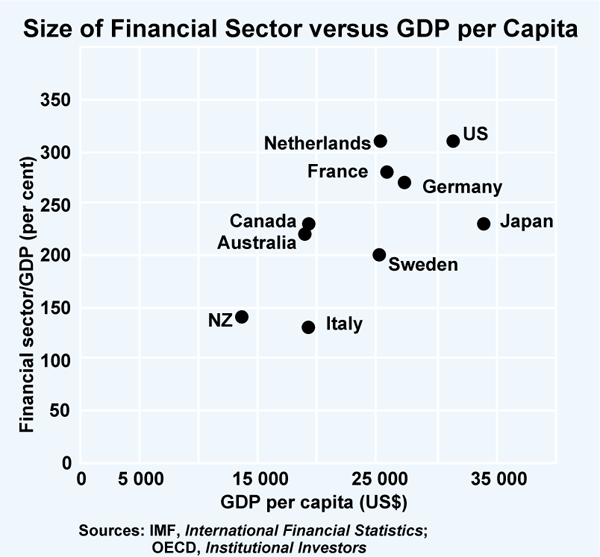
Financial development is also reflected, to a degree, in the structure of the financial system, rather than simply its size. One criterion, for example, is the extent to which countries rely on capital markets, rather than intermediaries, to allocate financing. On this measure, among the large industrial countries, the US is at one extreme and Germany at the other. Less than 30 per cent of the financing in the US economy is allocated through financial intermediaries, whereas in Germany the figure is around 75 per cent (Graph 10). Funds managers are more than twice as important as intermediaries in the US, but relatively unimportant in Germany. In this context, it is not surprising that the equity and corporate debt markets are very much larger (relative to GDP) in the US than in Germany, (Graphs 11 and 12). Which is the best method of allocating finance is, no doubt, a matter of debate but the relative performance of the US and European economies over the past decade would lead at least some to suggest that there are advantages in relying directly on capital markets.
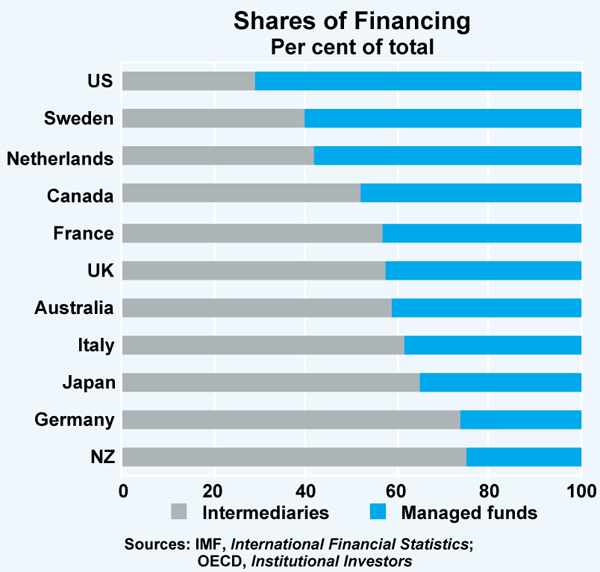
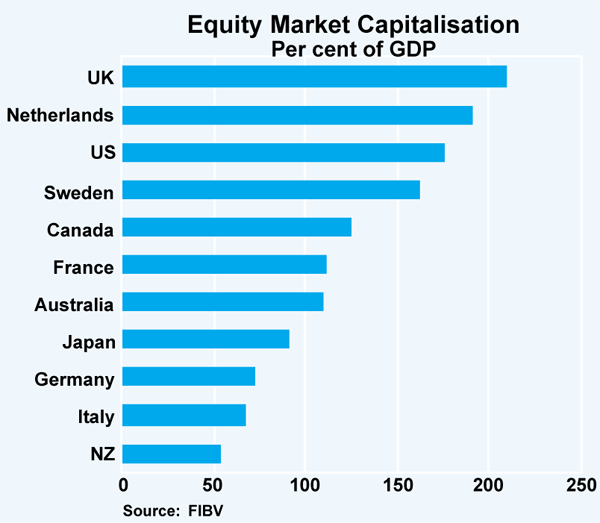
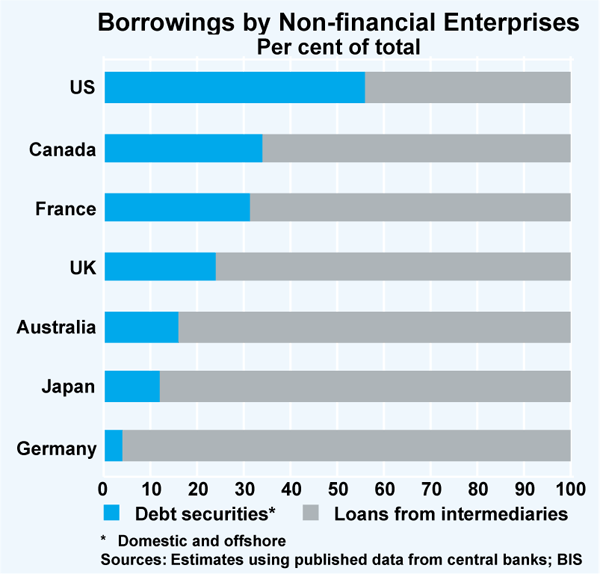
Leaving aside the extremes of the US and Germany, most other major countries have a greater balance in their mix of intermediary-based and capital market-based financing. Australia is in this group, with around 60 per cent of funding provided by intermediaries. But a number of other countries of similar size to Australia (e.g. Sweden and the Netherlands) are more towards the US model, and my guess is that that is where we are heading in the future.
Before I start looking ahead, however, let me finish the international comparison by focusing on the costs of financing. The facts here suggest that we have moved into line with industrial country norms, after having been well above in the 1980s. This is particularly the case for housing loans, where the average margin of banks has fallen to around 1.75 percentage points (the same as in other comparable countries) after having been well above (Graph 13). This pattern also holds for interest margins overall. Similarly, in the case of profitability, Australian banks are in line with comparable overseas banks (Graph 14).

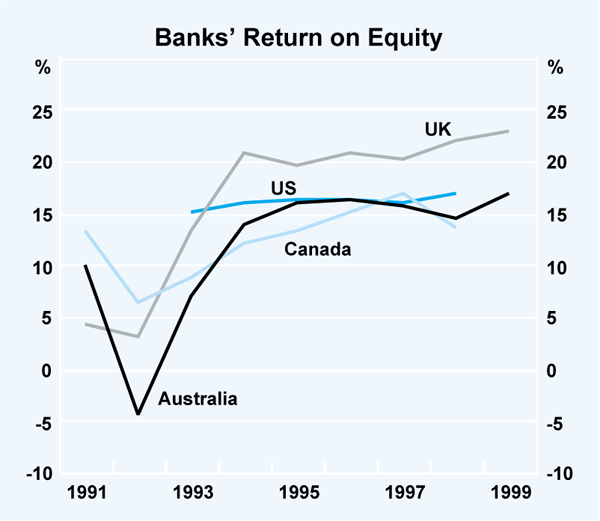
How Might the Financial System Develop over the Next 15 Years?
As I flagged at the outset, I will conclude by speculating a little about how the financial system might evolve over the next 15 years. In doing so, I will focus on broad structural trends rather than the cyclical swings that will inevitably happen.
Looking at where Australian financial markets sit in the world spectrum, the current situation might best be described as ‘work-in-progress’. Even though the financial sector has grown strongly, its size relative to the economy is still well behind the US, which in many respects might be seen as being at the leading edge of financial development and innovation.
Predicting how the financial system will develop is not something that can be done with precision. For one thing, it is hard to judge how much of the recent expansion, particularly in funds management, is cyclical – i.e. related to the strong performance of share markets – and how much is structural.
| Assets held with intermediaries |
Assets held with funds managers |
Total | ||
|---|---|---|---|---|
| $b | $b | $b | Per cent of GDP(a) | |
| 2000 | 810 | 520 | 1,330 | 225 |
| 2015 | 2,150 | 2,350 | 4,500 | 310 |
| Average annual growth rates (per cent) | ||||
| 1985–1999 | 11 | 16 | 12 | |
| 2000–2015 | 7 | 11 | 9 | |
| (a) Nominal GDP assumed to grow by 6 per cent a year | ||||
But one simple approach might be to say: given that the Australian financial system, in terms of size relative to the economy, is now roughly where the US system was 15 years ago, let's assume that in 15 years' time we reach the point where the US is now. Under this scenario, the Australian financial system might look something like Table 3 above.
Is such a scenario feasible? Is it consistent with current levels of savings in the economy, with realistic rates of increase in asset values, etc? I think the answer to these questions is ‘yes’.
The financial system would reach this size if, for example, its growth rate averaged 9 per cent a year over the next 15 years, a rate about 3 percentage points a year more than the likely growth rate of national income. That should be feasible: it is less than the annual average growth rate over the past 15 years, both in absolute terms and relative to GDP growth.
Whether it can be achieved will depend to an important degree on the rate of national savings and the rate of growth of asset prices, but reasonable assumptions suggest it is likely. For instance, such an outcome would be achieved if the community acquired financial assets at around the same rate as in the past, and if asset prices increased in real terms by 3 per cent a year. Hopefully, we might be able to achieve more than this if the increased contributions towards superannuation are not offset by reduced savings through other means.
Our experience, and that of the US, suggests that assets held with financial intermediaries will grow less quickly than other financial assets – on average only a little faster than GDP. If that is the case, the balance of financial assets will shift further in the direction of funds managers. That, in turn, will create additional demand for equity investments and corporate debt, in the latter's case particularly if governments continue to refrain from big debt issues. It would not be unrealistic, for example, to expect corporate bond issues to grow to the point where they accounted for 30–40 per cent of the economy's total debt needs, up from 15 per cent at present. That would be similar to where Canada is now, though still below where the US is.
Conclusion
Trends over the past 15 years and comparisons with other countries suggest that the Australian financial system will, on average, continue to grow faster than GDP, and that growth will be concentrated in the assets held with funds managers. This will continue to underpin expansion in financial market activity, particularly in emerging areas such as corporate debt. This is good news for more than just those working in financial markets. As the financial markets grow and mature, competition will produce greater benefits for the users, in terms of choice of products and more competitive interest rates and fees. And the economic performance of the country should also benefit. A diversified financial system with dynamic financial markets is more efficient at channelling funds to the most productive areas of the economy, and better able to help the economy absorb the various shocks to which it will no doubt be subjected from time to time.